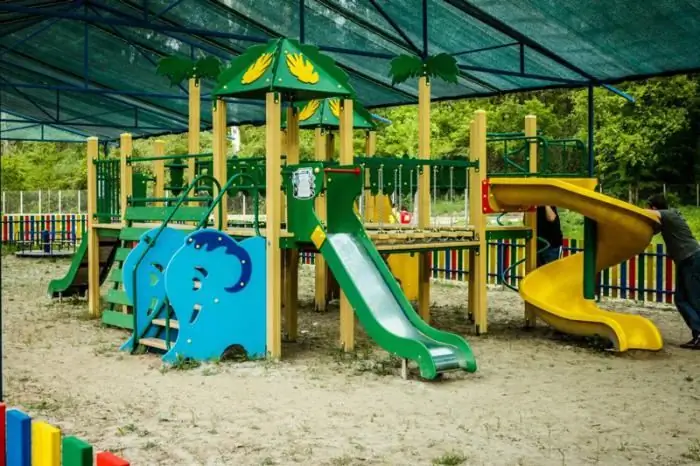- Author Harold Hamphrey [email protected].
- Public 2023-12-17 10:06.
- Last modified 2025-01-24 11:10.
In a sparsely populated part of the Crimean peninsula, there is a picturesque place unlike any other. This is Cape Tarkhankut. On the map of the peninsula, it can be found in the western part. At different times, the cape attracted the attention of scientists, archaeologists, artists and even directors. This place is full of natural and historical mysteries, and Cape Tarkhankut rarely reveals its secrets to the townsfolk.
From Turkic "tarkhan" is translated as "freed from tax" or "chosen one". Until the end of the 17th century, Tarkhan acts were widespread on the territory of the Crimean Khanate, according to which the inhabitants of a particular village were exempted from paying taxes.

Geography of Cape Tarkhankut
The peninsula, and in particular the cape, attracts geologists with its significant geological past. About two hundred million years ago, the cape was the bottom of a prehistoric ocean that has now disappeared. In support of this, petrified sea urchins, shells and various bones of marine animals, the ancient inhabitants of the ocean depths, were found in the surface fractures. Reaching up to one hundred and eighty meters above sea level, the cape is a hilly plain rising above the sea, originating indepth of the peninsula and ending with rocky cliffs of white limestone with many grottoes, arches and gorges. Although the climate of the peninsula has changed several times, today it is clearly a steppe climate with dry air in summer and humid in winter. Hot, even burning, the sun can warm the crystal clear water up to 28 degrees. Sometimes the water temperature reaches only 10 degrees, the reason for this is the cold current. The cold current season usually occurs in mid or late July. The holiday season opens in early June. In winter, severe frosts are characteristic, accompanied by high humidity and strong winds from the sea. The waters of the coast are teeming with valuable species of fish - these are varieties of sturgeon and mullet.
History of settlement of the peninsula
Information about the first settlers date back to the third millennium BC. Cape Tarkhankut was once chosen by the Scythians, because the peninsula is dotted with Scythian burial mounds. Like the entire coast of the Crimean peninsula, this area by the end of the first millennium consisted of ancient Greek colonies. At all times, sailors greatly appreciated the Narrow Bay, which is excellent for developing trade and contributing to the prosperity of the city.
Archaeological excavations
For a long time, archaeologists have been excavating on the territory of the Tarkhankut Peninsula, and there are no limits to new discoveries. Significant results were brought by the excavations of Belyaus, a Scythian settlement dating back to the fourth century BC. e. But the Karadzhy settlement (the village of Olenevka, Cape Tarkhankut) has seen the raids of the Cimmerians, Huns, Scythians, Greeks, Khazars and manyother conquerors and robbers. Also, excavations were carried out at the Pansky settlement (Yarylchagskaya Bay). But the excavations of the Greek city of Kalos had the largest scale, after which a museum was opened, exhibiting about five thousand exhibits (pithoi and amphorae, jewelry and ceramics with elements of Greek patterns). In general, over ten settlements were found and excavated along the entire coast.

Sights of the Cape
In addition to archaeological excavations and a museum, Cape Tarkhankut is famous for its special object - a 42-meter lighthouse. The construction of the lighthouse began in 1816. The walls, resistant to numerous winds and under the influence of other natural conditions, were built of Inkerman limestone. For all the time there were only cosmetic repairs. Currently, the lighthouse building is used as an exhibition hall for the display of old shipwreck anchors found by divers.

The depths of the sea surrounding the cape attract many scuba divers with their underwater world. The waters keep the secrets of sunken ships and underwater caves. It is possible that underwater grottoes hide the treasures of pirates who once entered the sheltered bay. Also under the water there is a unique museum of monuments of communist leaders, and the exhibits for this museum are brought by vacationers from all over the CIS countries. In support of the development of diving in this area, diving clubs are being created that provide equipment and support for diving in the waters of the Black Sea.

Cape Tarkhankut is a holiday you will never forget
The way to the village of Olenevka, located on Cape Tarkhankut, is hampered by the lack of direct highways, and this place was not included in the list of tourist routes that are very popular. The reference point for the traveler should be the village of Olenevka or Chernomorskoye. The easiest way to get there is by car, as traveling by train or bus involves many transfers. For lovers of extreme recreation and diving, there are already mentioned diving clubs and camping sites. And for a more relaxing journey, there is an almost thirty-kilometer beach area with boarding houses and mini-hotels.






